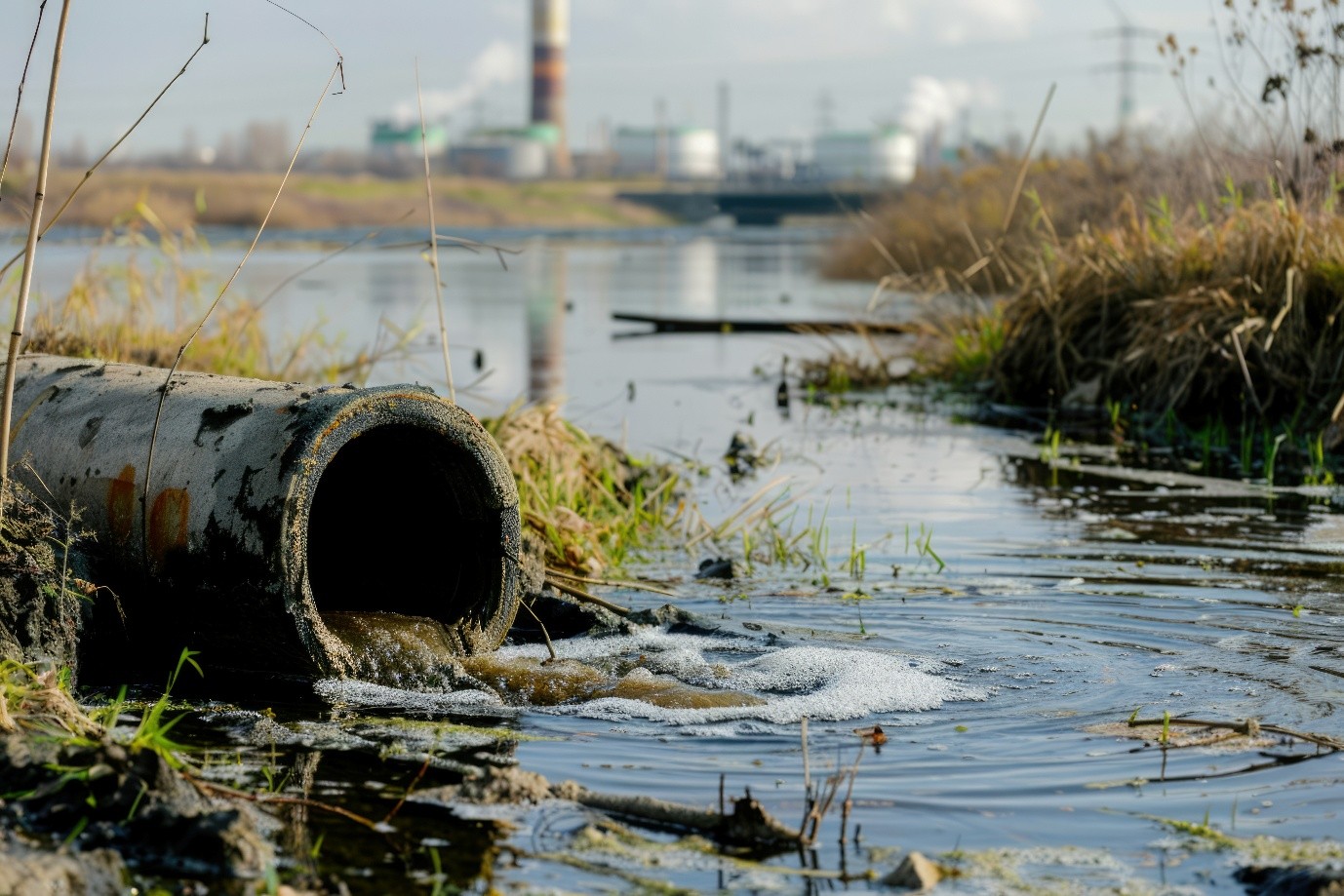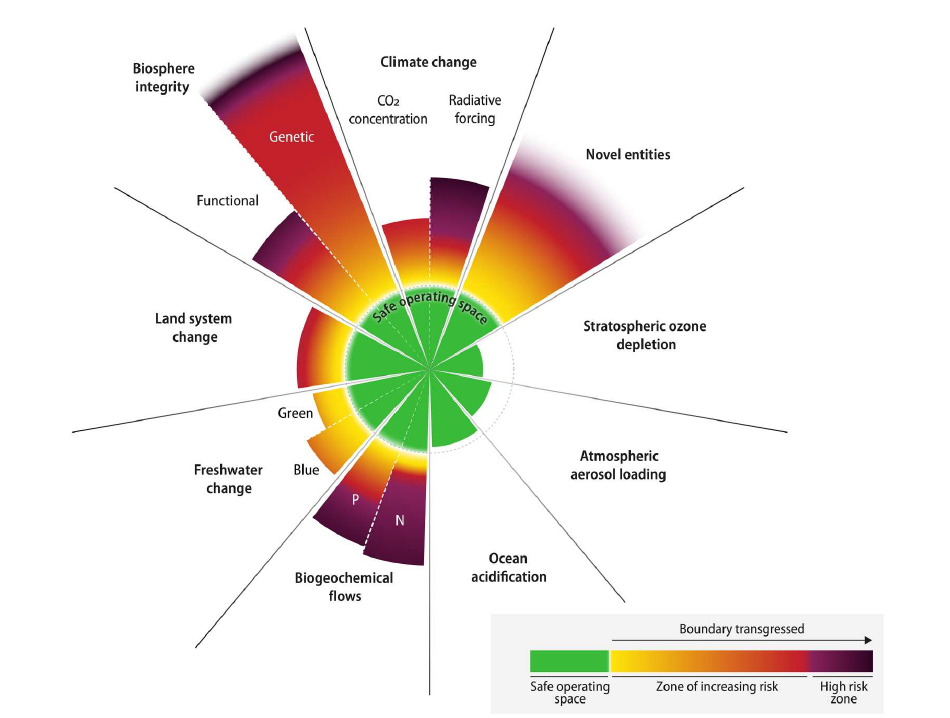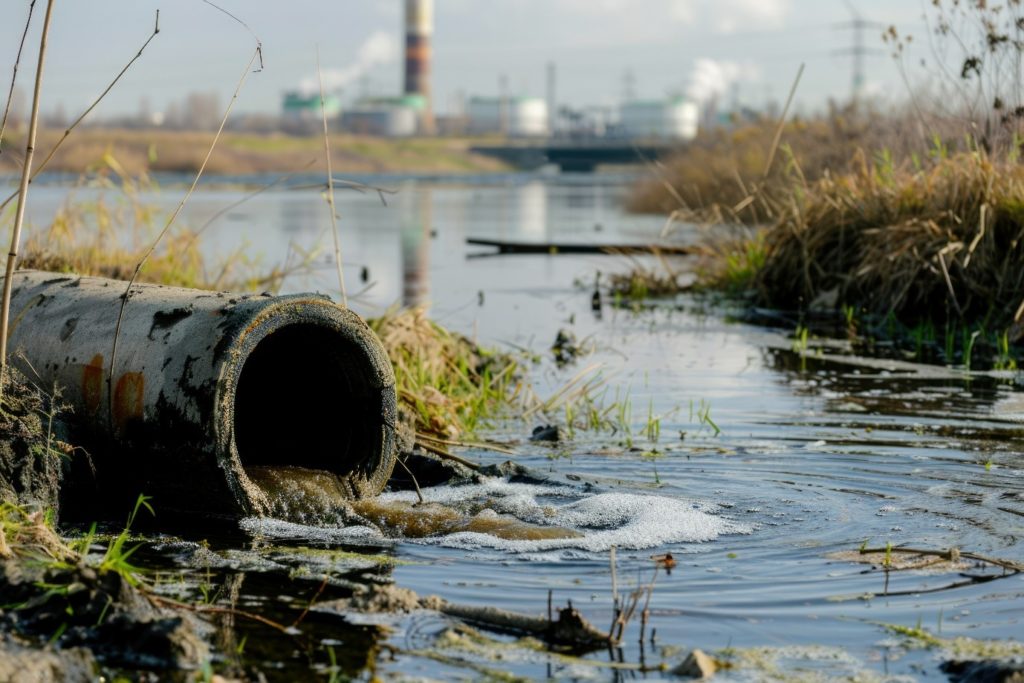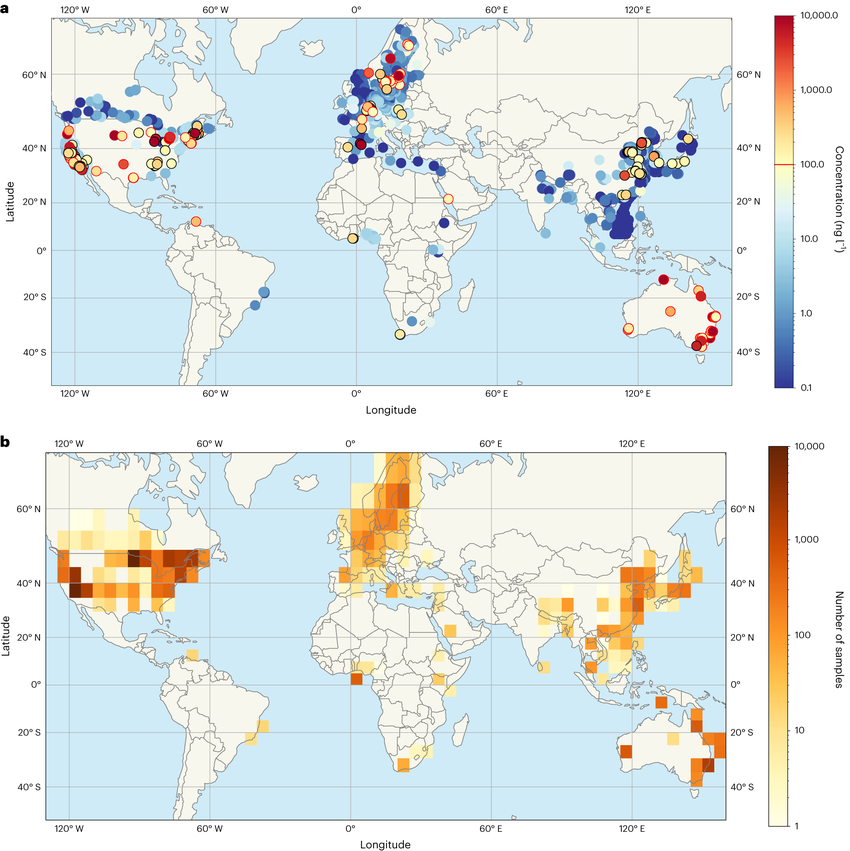
Operating within Boundaries
Novel Entities – PFAS
- PFAS, the “forever chemicals,” exemplify the dangers of crossing planetary boundaries, with severe impacts on ecosystems, human health, and economies.
- Sustainable alternatives and strong mitigation measures are essential to reduce PFAS risks, contain liabilities, and safeguard long-term resilience.

Fig.1: 2023 Status of Planetary Boundaries (Richardson et al., 2023)
Click to here learn more about planetary boundaries.
Earth is regulated by four interconnected systems—the atmosphere, hydrosphere, biosphere, and geosphere—that together support and sustain all life. To maintain this stability, scientists developed the Planetary Boundaries Framework, which identifies nine critical Earth processes that define a “safe operating space” for humanity. Crossing these boundaries risks irreversible environmental damage, yet seven of the nine have already been breached, with only aerosol loading and ozone depletion remaining within safe limits (Richardson et al., 2023; Findlay et al., 2025). Among these, novel entities such as synthetic chemicals and plastics are one of the least understood yet most urgent risks.

Fig.2: PFAS contamination through sewage waters
One of the most prominent and problematic novel entities is PFAS (perfluoroalkyl and polyfluoroalkyl substances). PFAS is a family of chemicals with over 4,700 man-made chemicals that have been used for nearly 60 years due to their strong resistance to heat, water, and chemicals (Panieri et al., 2022). This makes them useful in many everyday products, such as non-stick cookware like Teflon, waterproof clothing, and firefighting foam.

Fig.3: Concentration of PFAS around the World (Grunfeld et al., 2024)
However, their durability comes at a cost. PFAS do not break down in the environment, accumulate in living organisms, and are increasingly linked to serious health and ecological effects. A review of 220 peer-reviewed studies by the Environmental Working Group (EWG) found PFAS in over 600 species, including Canadian reindeer, Atlantic cod, and bony fishes (Ewg, n.d.). Another study detected PFAS in Arctic sea ice and meltwater, showing their ability to travel long distances and disrupt remote ecosystems. With PFAS holding such pertinence in the environment, it is not surprising to find it in our food as well. By consuming these PFAS-contaminated food and water, they will enter the human body, causing health concerns. The exposure to PFAS increases the risk of some cancers, interferes with human hormones and increases cholesterol levels and risks of obesity (Fenton et al., 2020). Therefore, the overall health of our environment, impacted by PFAS contamination, is intrinsically connected to human health.
Growing awareness of PFAS-related harms has prompted regulators worldwide to issue bans and advisories on their use. Research shows that the cost of remediation of PFAS released into the environment each year would likely exceed the world’s annual GDP of 106 trillion USD (Ling, 2024). Tackling PFAS pollution through environmental clean-up alone is unimaginably costly. At the same time, lawsuits against chemical companies producing these “forever chemicals” have surged. Because PFAS persist in ecosystems long after production ceases, manufacturers face sustained legal and financial risks. A recent example came in late July, when chemical giants were ordered to pay the state of New Jersey in the United States US$875 million for PFAS contamination (Tabuchi, 2025). This growing wave of litigation highlights a critical reality: the unchecked production of novel chemical entities not only carries mounting remediation costs but also exposes companies to escalating liabilities, ultimately driving up the cost of chemical production itself.
Many industries around the world rely heavily on PFAS in the production of goods that underpin both economies and livelihoods. In the United States alone, six key industries that depend on PFAS support more than six million jobs, pay over US$550 billion in wages annually, and contribute more than US$1 trillion to the national GDP (Meade, 2023). PFAS production has therefore become a critical building block of the global economy. Yet it is also a double-edged sword, bringing with it significant environmental and social costs. Looking at the world’s blue economy which contributed US$ 2.6 trillion in 2020, PFAS directly affects the blue economy due to contamination (OECD, 2025). This makes the sustainable use and regulation of PFAS essential to against financial losses.
In sectors where substitutes are available, shifting away from PFAS should be actively considered to safeguard companies against looming reputational and financial risks. The textile sector, for example, accounts for nearly half of global fluorotelomer-based PFAS consumption, mainly for waterproofing fabrics and treating carpets and leather (Kjølholt et al., 2015). While some companies fear that removing PFAS may compromise product performance, safer alternatives such as paraffin- and silicone-based coatings are already available (Baldock et al., 2024). Industries with viable substitutes must begin this transition to reduce environmental harm and lower financial risks tied to novel chemical entities.
By contrast, some industries still lack effective alternatives to PFAS. Semiconductor manufacturing is one such sector (Willson, 2025; The Environmental Council of the States (ECOS), 2024). In these cases, companies will need to adopt strong mitigation measures to ensure PFAS are effectively captured before wastewater is discharged. Technologies such as reverse osmosis, nanofiltration, and advanced wastewater treatment (A Guide to PFAS Remediation | Veolia WTS, n.d.) can help minimize releases, reduce liability, and protect corporate reputations. Beyond technical solutions, responsible production also requires proactive engagement with surrounding communities. Companies should consider the downstream impacts of their operations, address community concerns, and foster trust to reduce reputational risks while maintaining their social license to operate.
PFAS, often called “forever chemicals”, highlight the urgent need to operate within planetary boundaries. Their persistence shows what happens when production continues without regard for long-term impacts. The unchecked release of industrial chemicals threatens ecosystems and, in turn, human health. Respecting planetary boundaries is therefore not optional but essential for a safe and sustainable future.
As investors, we play a vital role in supporting companies on their transition toward cleaner and safer operations. Chemicals are essential in many industries, from consumer products such as non-stick cookware to critical safety applications like firefighting foams. Given this widespread reliance, it is crucial that these industries remain both profitable and sustainable. We look for businesses that acknowledge their environmental and social impacts, assess their exposure to ESG risks, and implement credible transition plans. By embedding sustainability into their strategies and aligning operations with planetary boundaries, companies can reduce risks, protect the environment, and build long-term resilience. We are committed to partnering with organizations that embrace this path of continuous value creation and responsible stewardship.
The Blueprint
With the ever-changing landscape around us, it can get overwhelming to stay up-to-date. The Blueprint highlights pertinent global Environmental, Social, and Governance (ESG) issues and their importance to investors and the wider community. We look forward to engaging in discussions about the interconnections between climate, nature, and social outcomes that impact our investments and our futures.
References
A guide to PFAS remediation | Veolia WTS. (n.d.). https://www.watertechnologies.com/blog/guide-pfas-remediation
Baldock, C., Grassi, F., Willis, J., & Manili, A. (2024). Novel Entities: A Financial Timebomb. In Planet Tracker. Planet Tracker. https://planet-tracker.org/wp-content/uploads/2024/09/Novel-Entities.pdf
Ewg. (n.d.). Global danger: Threatened and endangered species at risk from PFAS exposure. EWG © 2025. https://www.ewg.org/interactive-maps/pfas_in_wildlife/map/
Fenton, S. E., Ducatman, A., Boobis, A., DeWitt, J. C., Lau, C., Ng, C., Smith, J. S., & Roberts, S. M. (2020). Per‐ and Polyfluoroalkyl Substance Toxicity and Human Health Review: Current State of Knowledge and Strategies for Informing Future Research. Environmental Toxicology and Chemistry, 40(3), 606–630. https://doi.org/10.1002/etc.4890
Findlay, H. S., Feely, R. A., Jiang, L., Pelletier, G., & Bednaršek, N. (2025). Ocean acidification: another planetary boundary crossed. Global Change Biology, 31(6). https://doi.org/10.1111/gcb.70238
Grunfeld, D. A., Gilbert, D., Hou, J., Jones, A. M., Lee, M. J., Kibbey, T. C. G., & O’Carroll, D. M. (2024). Underestimated burden of per- and polyfluoroalkyl substances in global surface waters and groundwaters. Nature Geoscience, 17(4), 340–346. https://doi.org/10.1038/s41561-024-01402-8
Kjølholt, J., Mikkelsen, S. H., Warming, M., Jensen, A. A., COWI A/S, NIPSECT, Aarhus University, & Danish Technological Institute. (2015). Polyfluoroalkyl substances (PFASs) in textiles for children. In C. Lassen (Ed.), Survey of Chemical Substances in Consumer Products [Report]. The Danish Environmental Protection Agency. https://www2.mst.dk/Udgiv/publications/2015/04/978-87-93352-12-4.pdf
Ling, A. L. (2024). Estimated scale of costs to remove PFAS from the environment at current emission rates. The Science of the Total Environment, 918, 170647. https://doi.org/10.1016/j.scitotenv.2024.170647
Meade, D. (2023). Quantifying the Economic Contribution of Key Industries which use PFAS as Vital Inputs. In Inforum, The Sustainable PFAS Action Network (SPAN), & JMS Consulting, Sustainable PFAS Action Network. https://static1.squarespace.com/static/63501375c76c8d7d70cd9705/t/64dbca2cf3de7f4935a2cd19/1692125740697/INFORUM+National+PFAS_EconContribution_FINAL.pdf
OECD. (2025). The ocean Economy to 2050. OECD Publishing. https://www.oecd.org/content/dam/oecd/en/publications/reports/2025/03/the-ocean-economy-to-2050_e3f6a132/a9096fb1-en.pdf
Panieri, E., Baralic, K., Djukic-Cosic, D., Djordjevic, A. B., & Saso, L. (2022). PFAS molecules: a major concern for the human health and the environment. Toxics, 10(2), 44. https://doi.org/10.3390/toxics10020044
Reuters. (2023, June 29). Solvay reaches nearly $393 million PFAS settlement with New Jersey. Reuters. https://www.reuters.com/sustainability/solvay-settles-drinking-water-pollution-claims-with-new-jersey-2023-06-28/
Richardson, K., Steffen, W., Lucht, W., Bendtsen, J., Cornell, S. E., Donges, J. F., Drüke, M., Fetzer, I., Bala, G., Von Bloh, W., Feulner, G., Fiedler, S., Gerten, D., Gleeson, T., Hofmann, M., Huiskamp, W., Kummu, M., Mohan, C., Nogués-Bravo, D., . . . Rockström, J. (2023). Earth beyond six of nine planetary boundaries. Science Advances, 9(37). https://doi.org/10.1126/sciadv.adh2458
Tabuchi, H. (2025, August 4). Chemical Makers to Pay N.J. $875 Million to Settle ‘Forever Chemicals’ Claims. New York Times. https://www.nytimes.com/2025/08/04/climate/new-jersey-pfas-settlement.html
The Environmental Council of the States (ECOS). (2024, May 28). PFAS Industry data – The Environmental Council of the States (ECOS). https://www.ecos.org/pfas/pfas-industry-data/#:~:text=Top%20Industries%20Identified,Semiconductor%20Industry
Willson, M. (2025, June 16). ‘Forever chemicals’ industry aims to capitalize on AI boom. E&E News by POLITICO. https://www.eenews.net/articles/forever-chemicals-industry-aims-to-capitalize-on-ai-boom/
Important Information
This material is provided by Phillip Capital Management (S) Ltd (“PCM”) for general information only and does not constitute a recommendation, an offer to sell, or a solicitation of any offer to invest in any of the exchange-traded fund (“ETF”) or the unit trust (“Products”) mentioned herein. It does not have any regard to your specific investment objectives, financial situation and any of your particular needs.
The information provided herein may be obtained or compiled from public and/or third party sources that PCM has no reason to believe are unreliable. Any opinion or view herein is an expression of belief of the individual author or the indicated source (as applicable) only. PCM makes no representation or warranty that such information is accurate, complete, verified or should be relied upon as such. The information does not constitute, and should not be used as a substitute for tax, legal or investment advice.
The information herein are not for any person in any jurisdiction or country where such distribution or availability for use would contravene any applicable law or regulation or would subject PCM to any registration or licensing requirement in such jurisdiction or country. The Products is not offered to U.S. Persons. PhillipCapital Group of Companies, including PCM, their affiliates and/or their officers, directors and/or employees may own or have positions in the Products. This advertisement has not been reviewed by the Monetary Authority of Singapore.
